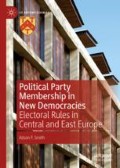Abstract
This chapter examines the role of party members in Lithuania. Surveys and interviews were used to gather information about the roles of party members in the Homeland Union—Lithuanian Christian Democrats and the Lithuanian Social Democratic Party. Using this data, the sub-hypotheses developed in Chap. 2 are tested. It is found that Lithuania’s single member districts encourage candidate-centred campaigning, with parties’ efforts ‘targeted’ towards the specific districts where parties have the greatest chances of success. Grassroots campaigning strategies were adopted at the district level during parliamentary campaigns, and also during municipal campaigns. Lithuania’s 72-hour ‘silence period’ also increased the value of members as ‘ambassadors in the community’ and ‘loyal and reliable voters’.
Access this chapter
Tax calculation will be finalised at checkout
Purchases are for personal use only
References
Carey, J. M., & Shugart, M. S.(1995). Incentives to Cultivate a Personal Vote: A Rank Order of Electoral Formulas. Electoral Studies, 14(4), 417–439.
Cox, G. W. (1990). Electoral Rules and the Calculus of Mobilization. Legislative Studies Quarterly, 24(3), 387–419.
Duverger, M. (1954). Political Parties. Bristol: Western Printing Services Ltd.
Gherghina, S. (2015). Party Organisation and Electoral Volatility in Central and Eastern Europe. Abingdon: Routledge.
Ibenskas, R. (2012). Activists of Money? Explaining the Electoral Success and Persistence of Political Parties in Lithuania. Party Politics, Published Online 9th October 2012.
Kirchheimer, O. (1969). The Transformation of the Western European Party System. In F. S. Burin & K. L. Shell (Eds.), Politics, Law and Social Change: Selected Essays of Otto Kirchheimer. New York: Columbia University Press.
Mair, P., & Katz, R. S. (1997). Party Organization, Party Democracy and the Emergence of the Cartel Party. In P. Mair (Ed.), Party System Change: Approaches and Interpretations. Oxford: Clarendon Press.
May, J. (1973). Opinion Structure of Political Parties: The Special Law of Curvilinear Disparity. Political Studies, 21(2), 135–151.
Panebianco, A. (1988). Political Parties: Organization and Power. Cambridge: Cambridge University Press.
Scarrow, S. E. (1995). Political Parties and Their Members: Organizing for Victory in Britain and Germany. Oxford: Oxford University Press.
Smith-Sivertsen, H. (2004). Why Bigger Party Membership Organisations in Lithuania than in Latvia, 1995–2000. East-European Quarterly, 38(2), 215–259.
Tavits, M. (2013). Post-Communist Democracies and Party Organization. Cambridge: Cambridge University Press.
van Biezen, I. (2003). Political Parties in New Democracies: Party Organization in Southern and East-Central Europe. Basingstoke: Palgrave Macmillan.
Wellhofer, E. S. (1972). Dimensions of Party Development: A Study in Organizational Dynamics. The Journal of Politics, 34(1), 153–182.
Wolinetz, S. B. (2002). Beyond the Catch-All Party: Approaches to the Study of Parties and Party Organization in Contemporary Democracies. In R. Gunther et al. (Eds.), Political Parties: Old Concepts and New Challenges. Oxford: Oxford University Press.
Zittel, T., & Gschwend, T. (2008). Individualised Constituency Campaigns in Mixed-Member Electoral Systems: Candidates in the 2005 German Elections. West European Politics, 331(5), 978–1003.
Author information
Authors and Affiliations
Rights and permissions
Copyright information
© 2020 The Author(s)
About this chapter
Cite this chapter
Smith, A.F. (2020). The Role of Party Members in Lithuania. In: Political Party Membership in New Democracies. St Antony's Series. Palgrave Macmillan, Cham. https://doi.org/10.1007/978-3-030-41796-3_4
Download citation
DOI: https://doi.org/10.1007/978-3-030-41796-3_4
Published:
Publisher Name: Palgrave Macmillan, Cham
Print ISBN: 978-3-030-41795-6
Online ISBN: 978-3-030-41796-3
eBook Packages: Political Science and International StudiesPolitical Science and International Studies (R0)

